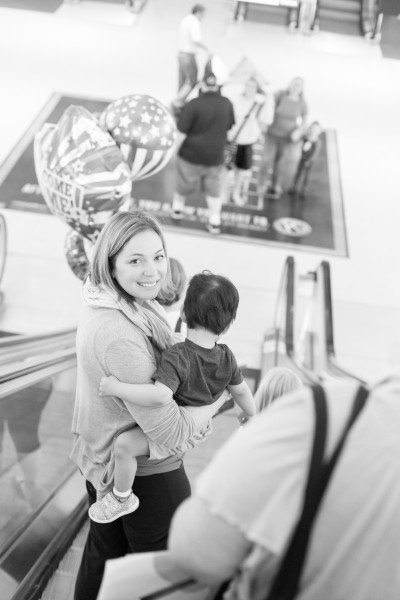Dear Family and Friends,
After so much preparing, hoping and waiting – our precious little one is almost home! We know that each of you receiving this letter has, in some way, supported, loved and prayed for us. Because we know your care for our child and our family, we want to share with you some information that we hope will best equip everyone around him to assist us in laying the strongest and healthiest foundation – emotionally, physically and spiritually.
In many ways, our new one will be like the children who entered our family through birth. We will raise him up to know and love the Lord — using daily His guidance and care as we parent him. But there will be a few differences in the beginning as our son learns what family is.
As we have been preparing to bring him home, we have researched bonding and attachment in children, especially those coming home through adoption from an institutional orphanage setting. We are certain that God’s design of our hearts and minds is perfect. His heart for us so often displayed in a family’s love for each other — and the children’s natural trust of their parents. However, for many children raised thus far in institutions, this natural trust has never been established and will take more time to form between our child and us beginning the day we meet him.
Usually the primary caregiver (often mommy) meets the immediate need and soothes the baby. This starts from infancy and is repeated consistently over and over through the formative years. With each response of the caregiver to a cry or need trust is built. This trust which takes time, lays an important foundation in their hearts. It will overflow into every relationship and how they relate to future relationships with family and friends – and this is why it’s so important for us to involve you and share our attachment plan with you. We want our child to establish first a healthy connection with us as his parents so it may overflow into relationships with grandparents, aunts, uncles, cousins and friends!
Children who come home through adoption have experienced interruptions in this typical attachment process. The loss of a biological mother at an early age can be a major trauma on their little hearts and how they relate to the others. The care has looked different for every child in an institution setting, and for the first few weeks we will just be getting glimpses of the things he has missed and trying our best to meet each need to begin to reverse patterns formed — to show him that when he cries, we are there to meet his needs. With each need being met we will be establishing trust — with the parent to child trust being built first.
We want to rebuild the child/parent relationship — and we really need everyone’s help and support as we do this. The best way for him to see us as his parents will be for us to be the only ones to meet his needs and cries for a time. (Don’t worry — this won’t be forever! We will very much need babysitters and grandmas to feed him favorite snacks in time!) Because we are bringing home a little one who is already walking and talking, our child may walk up to you at family gatherings and ask you for help with something, for something to eat or drink or want to just snuggle. In the orphanage setting, any caregiver might meet his need, but at first we need to be the ones meeting his needs. For that reason, you can help us by redirecting our little one to mommy and daddy if he asks you for something. Over time he will see us as his primary caregivers, and he will learn that we are safe to trust. After he has a healthy relationship established with us, he will be able to branch out to other, healthy relationships.
At first, it may seem we have a lot of structure, boundaries and close proximity to our child. Please know that these decisions are prayerfully and thoughtfully made choices based on immense amounts of research and instruction from trusted adoption mentors. We will be doing what we believe is best to help him heal from those interruptions in attachment as effectively as possible. While he may be an active little preschooler, if he wants to be rocked and drink from a bottle – because he missed this with a mommy and daddy – we will give him this gift. We will move on to the next thing developmentally when he is emotionally ready. We want to give him time to heal emotionally, and we also want to give him the bonding moments we gave all of our children.
Why are we telling you all of this? Because you will actually play an awesome and vital role in helping our son settle in, heal, and lay a foundation for the future. There are a few areas in which you can help us:
The first is to set physical boundaries. It will help us immensely if adults limit what is typically considered normal, physical contact with our new one. This will (for a while) include things like holding, excessive hugging and kissing. Children from orphanage settings are prone to attach too easily to anyone and everyone – which hinders the important, primary relationship with parents. Waving, blowing kisses or high fives are perfectly appropriate and welcomed! He should know that the people with whom he interacts are our trusted friends.
The second is to be patient and understanding with us as we hunker down at home for awhile. Children raised in institutional settings are not used to the pace of life we live here always on the go. Leaving home for years has meant maybe walking down the hall or going to the small playground gated around the orphanage. Riding in a car at first will be over stimulating and cause sensory overload. We want to ease him into all the changes he will be experiencing from new family, new language and a new home – so our first months we may be limiting our outings closely watching how he handles one change at a time. This is called “cocooning” where you stay at home for a bit – just like a new mom stays home from the hospital after having a newborn. Only our time at home will be with a very much awake preschooler getting to know new foods, new sounds, and new surroundings.
As each new thing becomes comfortable to our child, we will slowly introduce him to new environments. This will not be easy for us as we are very used to being on the go. Our children already in our family will still have a desire and need for refreshment, so please feel like you can reach out and ask if they need a play date or outing while we stay home.
We are incredibly blessed to have so many loved ones around us. We couldn’t ask for a better extended family and circle of friends for our precious child. While we are over the moon excited to bring our child home, we are also very nervous – and will need your prayers and help to help us settle in and connect to our new one. Thank you so much for your love and support in this time of growing. We count each of you as such a special part of our family – and we can’t wait for our child to know you and love each of you as much as we do!
We love you all,
Andrea and Richard Young
– images courtesy of Krissi Trusty




























God hand picked each and everyone of you patents who choose to adopt an orphan ! God stitched a special piece in your hearts ❤ and souls to be that child’s mommy and daddy! Thank God for special people like you! God Bless you all